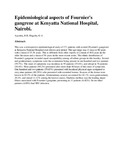| dc.contributor.author | Ayumba, B R | |
| dc.contributor.author | Magoha, G A | |
| dc.date.accessioned | 2013-02-24T08:57:06Z | |
| dc.date.issued | 1998-10 | |
| dc.identifier.citation | East Afr Med J. 1998 Oct;75(10):586-9. | en |
| dc.identifier.uri | http://erepository.uonbi.ac.ke:8080/xmlui/handle/123456789/10942 | |
| dc.identifier.uri | http://www.ncbi.nlm.nih.gov/pubmed/10065193 | |
| dc.description.abstract | This was a retrospective epidemiological study of 171 patients with scrotal (Fournier's gangrene) at Kenyatta National Hospital over eleven year period. The age range was 11 days to 90 years with a mean of 35.38 years. This is different from other reports of a mean of 40.6 years in the older literature and a mean of 50 years in the more recent series. The ethnic distribution of Fournier's gangrene revealed equal susceptibility among all ethnic groups in this locality. Scrotal and genitourinary symptoms were the commonest being present in one hundred and two patients (59.7%). The onset of symptoms was insidious in 95 patients (55.6%), and abrupt in 76 patients (44.4%). Most patients (84.2%) presented after more than 48 hours of the onset of symptoms. One hundred and two patients (59.65%) presented with localised physical signs compared to sixty nine patients (40.35%) who presented with extended lesions. Sources of the lesion were known in 82.5% of the patients. Genitourinary sources accounted for 42.1%, extragenitourinary 29.2%, and mixed 11.11% among the known causes. Diabetes mellitus was the leading major illness associated with Fournier's gangrene, presenting in 11 patients (6.42%). Seven other patients (4.09%) had HIV infection. | en |
| dc.language.iso | en | en |
| dc.subject | Epidemiological | en |
| dc.subject | Fournier's gangrene | en |
| dc.title | Epidemiological aspects of Fournier's gangrene at Kenyatta National Hospital, Nairobi. | en |
| dc.type | Article | en |
| local.publisher | Department of Surgery, College of Health Sciences, University of Nairobi. | en |

